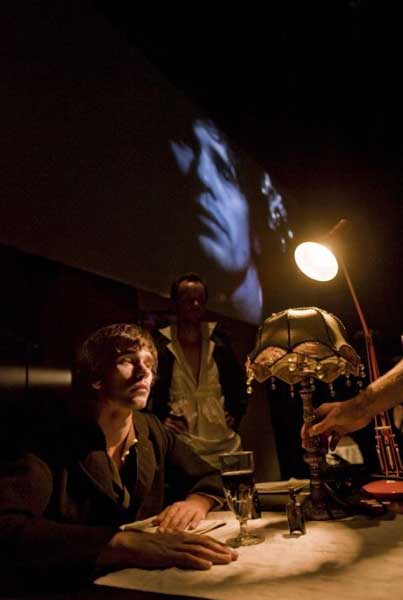...Some Trace of Her, National Theatre: Cottesloe, London

Your support helps us to tell the story
From reproductive rights to climate change to Big Tech, The Independent is on the ground when the story is developing. Whether it's investigating the financials of Elon Musk's pro-Trump PAC or producing our latest documentary, 'The A Word', which shines a light on the American women fighting for reproductive rights, we know how important it is to parse out the facts from the messaging.
At such a critical moment in US history, we need reporters on the ground. Your donation allows us to keep sending journalists to speak to both sides of the story.
The Independent is trusted by Americans across the entire political spectrum. And unlike many other quality news outlets, we choose not to lock Americans out of our reporting and analysis with paywalls. We believe quality journalism should be available to everyone, paid for by those who can afford it.
Your support makes all the difference.Ben Whishaw – who is soon to be seen as Sebastian in the film of Brideshead Revisited – is a striking theatrical performer and a haunting camera-subject. He gets to demonstrate that he's both in the latest, extraordinarily compelling, multi-media piece by the controversial, audience-polarising director Katie Mitchell.
Inspired by Dostoevsky's 1868 novel, The Idiot, the new show develops the techniques she deployed two years ago in her devised piece Waves. That production took a novel by Virginia Woolf, which consists entirely of inner monologues, and found a potent way of conveying its negotiations between external reality and the characters' streams of consciousness. It did this through a performance style in which there was an expressive split between the physical presence of the actors and the video footage created live by the cast, as though in a cross between a film and a radio studio, and replete with DIY sound effects, at every show.
The Idiot, by contrast, has plenty of plot, but it's the extreme states within it that interest Mitchell and her crack technical team – Leo Warner (director of photography), Vicki Mortimer (designer) and Paule Constable (lighting).
Its hero, Prince Myshkin (Whishaw), is a sensitive "holy fool" figure who is subject to epileptic fits. He feels a Christ-like compassion for Nastasya Filippovna, a beauty who was abused, as a girl, by a sugar-daddy and now, in contempt for herself and the world, plays up to her reputation as a wilful fallen woman. This puts Myshkin in mortal danger from her jealous, obsessive admirer Rogozhin.
Mitchell's devised show brilliantly gets inside the nervous system of a book that conveys what it is like to feel ecstatic joy at existence – in the vertiginous second before the topple into a fit, or into rage against a maker who lets you die early of consumption.
Mitchell's approach is as far from that of the classic serial as can be imagined. The cast double as technicians and performers, setting up the beautifully composed and beautifully lit shots that are presented in black and white, and deliberately evocative of 19th-century photography. Whishaw's spiritually anguished and sweating face is examined, in intense close-ups, on the big screen that dominates the proceedings. His eyes spasm in sudden, photo-flash freeze-frames before oncoming fits fling back his head.
Suggestive of a heightened, off-the-scale awareness, there are hallucinatory images, including a fob-watch that becomes, when crushed in his fist, a handful of earth from which a flower hopefully springs, or soup in a bowl that turns into a wriggling mass of maggots. There's the constant sense of people who are living on the edge – I was often reminded of the line in TS Eliot's The Love Song of J Alfred Prufrock: "as if a magic lantern threw the nerves in patterns on a screen".
The tension is raised by the fact that we see the actors scurrying to create complicated set-ups. These gel on the often split-screen, but are calculatedly cubist in their angled dislocation on stage. Two people conversing on film will be sitting at opposite ends of the acting space, and "their" hands, which nervously fiddle with cigarettes or stroke an ominous knife, are provided by other performers in psychologically fractured extension of the idea of the movie body-double.
Verses from the American poet Emily Dickinson about the moral sensation of existentially acute predicaments ("I could not feel to feel") are eloquently woven into the dark texture of the piece.
Hattie Morahan is wonderfully unnerving as the beautiful Nastasya, her manner imperious, her eyes blazing in a mix of anger and terror, and her sense of herself as soiled goods demonstrated by the doll she bathes in dirt. Mitchell could beef up the presentation of Aglaya (Nastasya's rival) and of Rogozhin (her nemesis), who both need to be stronger to be explicable to newcomers to The Idiot.
Yet ...some trace of her is a deeply imaginative response to certain aspects of the novel, not a dutifully illustrated crib.
To 13 August (020-7452 3000)
Join our commenting forum
Join thought-provoking conversations, follow other Independent readers and see their replies
Comments